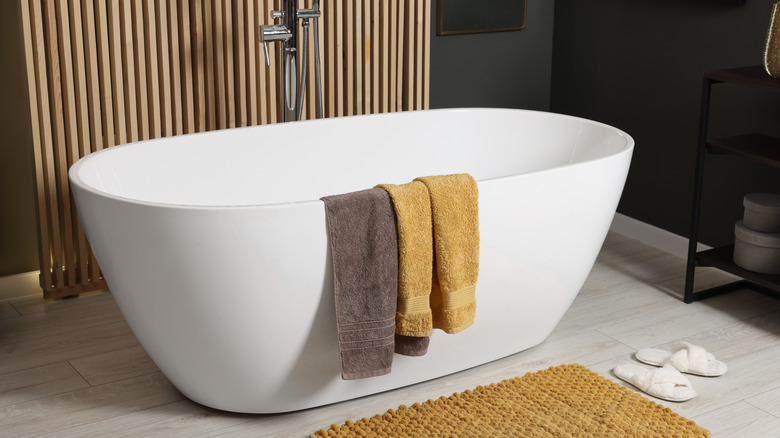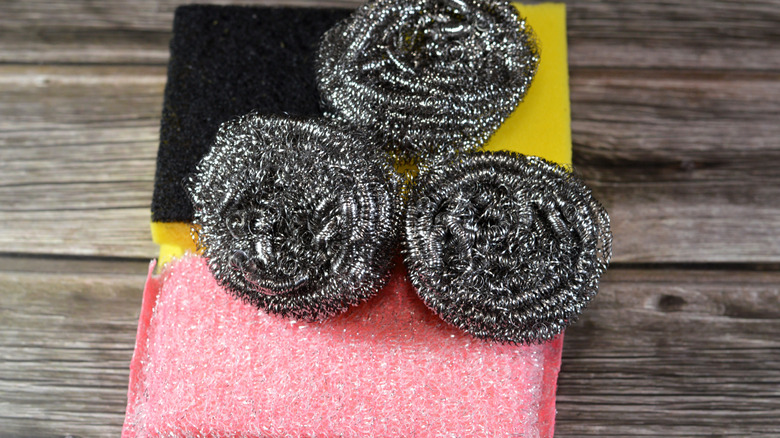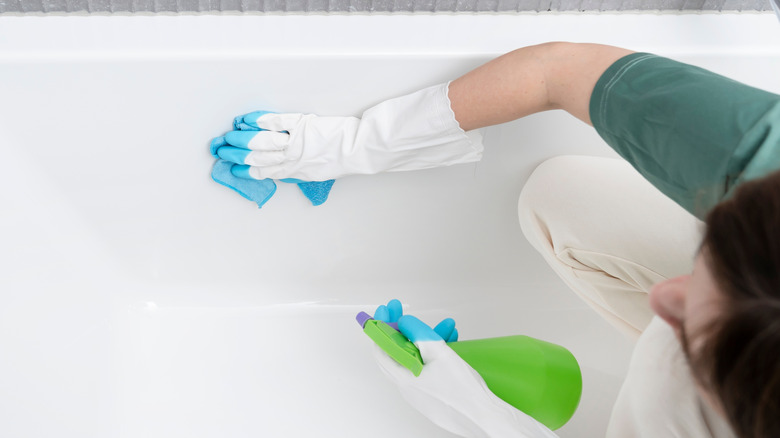Avoid These Cleaning Mistakes For Your Reglazed Tub To Prevent Damage
We may receive a commission on purchases made from links.
Choosing to reglaze your bathtub versus replacing it can give you many additional years of relaxation and use out of your tub. Reglazing takes care of surface scratches and stains, transforming your dull tub surface into a shiny new one at a fraction of the cost of replacing it. This process takes four to eight hours but can extend the life of your tub by 10 to 15 years if maintained correctly.
Part of proper reglazed tub maintenance is cleaning it the right way. While you might have used abrasive scrub brushes and powder cleaners in the past, you shouldn't use these on your reglazed tub unless you want to see damage like peeling, fading, or chipping. This damage can be repaired with touch-up kits if it's minor, but major damage will require even more labor (and money) to repair properly. Additionally, avoid using powerful sprays of water and steam, since these can also damage the surface.
It's important to clean your reglazed tub weekly to avoid a buildup of grime and dirt, which, if left untreated, will cause damage to your tub's new surface. You may need to switch out the trusted products you've been using for milder options to clean your reglazed tub and keep it looking new.
Don't clean your glazed tub with these methods
When cleaning your reglazed tub, you should avoid using anything abrasive. This includes cleaners like Ajax, Comet, and Bar Keepers Friend, as well as abrasive sponges and steel wool. Abrasive cleaners and tools can scratch and ultimately dull the reglazed surface. Additionally, you want to avoid harsh chemicals like ammonia and bleach since this can cause discoloration and damage the tub's finish, leading to peeling and chipping.
While using powerful water streams to clean your reglazed tub might seem like a good idea, it's best to avoid it. This includes using a steam cleaner or power washer — steam cleaners generally don't clean the reglazed surface well and can damage the finish. Power washers are too powerful, leading to peeling. Plus, using any of these methods can void your warranty.
Understanding the cleaning techniques you should and shouldn't use is one crucial thing you need to know before refinishing your bathtub. Using effective cleaning methods that won't damage the sleek and shiny reglazed surface of your tub can allow you to enjoy it for the expected 10 to 15-year lifespan, while without proper maintenance this could drop significantly.
Effective cleaning techniques
So, what is the best way to clean your reglazed tub so that you don't cause unnecessary damage to its beautiful surface? For the first 30 days after your tub has been reglazed, only use mild dish soap, like Dawn Liquid Dish Soap, and a soft towel or sponge to clean. After the first month, you can use a non-abrasive cleaning solution like Lysol Tub and Tile Cleaner, Mr. Clean All Multi-Surface Liquids, or CRL Bathroom & Kitchen Cleaner. You'll want to start by slowly rinsing the tub with warm water, then apply your chosen cleaner and let it sit for a few minutes. Scrub with a soft, non-abrasive sponge or cloth, then gently rinse the tub again with warm water from a cup or bowl.
Add your reglazed tub to the list of things that you should be cleaning with a microfiber cloth. This type of cloth isn't abrasive, so you can use it at the end of your cleaning and after every use to dry the residual water from the tub since leaving water droplets can lead to mineral deposits and water spots that can weaken the finish over time.
Bathtub reglazing can make your tub look shiny and new for years to come, but it is a delicate thing to take care of. Common reglazing problems can include cracking, peeling, fading, and chipping. While properly cleaning your reglazed tub can help to ensure its longevity, a more durable alternative to bathtub refinishing may be perfect for your home, such as a tub liner or insert, if you aren't likely to stick to gentle cleaning methods.


